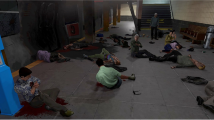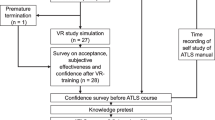Abstract
We describe the design and development of an Extended Reality Advanced Trauma Life Support (ATLS) simulator that incorporates several ATLS scenarios. ATLS is a training program developed by the American College of Surgeons for teaching medical practitioners a systematic approach to treating trauma patients. The ATLS simulator is based on case-level data, which helps create reusable medical training scenarios. The simulation consists of three components, namely, incident history, initial assessment and resuscitation, and a secondary survey. It provides several scenarios for medical practitioners to perform the tasks from the ATLS checklist and practice diagnosing patients. The simulator can also predict the requirement of an ICU room, ventilator and the length of stay for a given trauma patient based on the type and severity of their injury. With our ATLS simulator we aim to provide medical practitioners a comprehensive training module for practicing emergency trauma response.
Access this chapter
Tax calculation will be finalised at checkout
Purchases are for personal use only
Similar content being viewed by others
References
The cost of medical VR training. https://axonpark.com/the-cost-of-medical-vr-training/. Accessed 11 Nov 2021
Trauma registry resources (2022). https://www.ptsf.org/trauma-registry/trauma-registry-resources. Accessed 11 Jan 2022
Brooke, J., et al.: SUS–a quick and dirty usability scale. Usability Eval. Ind. 189(194), 4–7 (1996)
de Carvalho Fürst, R.V., Polimanti, A.C., Galego, S.J., Bicudo, M.C., Montagna, E., Corrêa, J.A.: Ultrasound-guided vascular access simulator for medical training: proposal of a simple, economic and effective model. World J. Surg. 41(3), 681–686 (2017)
Cecil, J., Gupta, A., Pirela-Cruz, M.: An advanced simulator for orthopedic surgical training. Int. J. Comput. Assist. Radiol. Surg. 13(2), 305–319 (2017). https://doi.org/10.1007/s11548-017-1688-0
Daghistani, T.A., Elshawi, R., Sakr, S., Ahmed, A.M., Al-Thwayee, A., Al-Mallah, M.H.: Predictors of in-hospital length of stay among cardiac patients: a machine learning approach. Int. J. Cardiol. 288, 140–147 (2019)
Dasgupta, A., Manuel, M., Mansur, R.S., Nowak, N., Gračanin, D.: Towards real time object recognition for context awareness in mixed reality: a machine learning approach. In: 2020 IEEE Conference on Virtual Reality and 3D User Interfaces Abstracts and Workshops (VRW), pp. 262–268 (2020). https://doi.org/10.1109/VRW50115.2020.00054
De Ponti, R., Marazzato, J., Maresca, A.M., Rovera, F., Carcano, G., Ferrario, M.M.: Pre-graduation medical training including virtual reality during COVID-19 pandemic: a report on students’ perception. BMC Med. Educ. 20(1), 1–7 (2020)
Farra, S.L., et al.: Comparative cost of virtual reality training and live exercises for training hospital workers for evacuation. Comput. Inform. Nurs. CIN 37(9), 446 (2019)
Farshid, M., Paschen, J., Eriksson, T., Kietzmann, J.: Go boldly!: explore augmented reality, virtual reality, and mixed reality for business. Bus. Horiz. 61(5), 657–663 (2018)
Frantz, T., Jansen, B., Duerinck, J., Vandemeulebroucke, J.: Augmenting Microsoft’s HoloLens with Vuforia tracking for neuronavigation. Healthc. Technol. Lett. 5(5), 221–225 (2018)
Gauthier, N., et al.: Does cardiac physical exam teaching using a cardiac simulator improve medical students’ diagnostic skills? Cureus 11(5) (2019)
Gilliland, M.: The Business Forecasting Deal: Exposing Myths, Eliminating Bad Practices, Providing Practical Solutions. Wiley, Hoboken (2010)
Gilpin, D., Nelson, P.: Revised trauma score: a triage tool in the accident and emergency department. Injury 22(1), 35–37 (1991)
Handosa, M., Schulze, H., Gračanin, D., Tucker, M., Manuel, M.: Extending embodied interactions in mixed reality environments. In: Chen, J.Y.C., Fragomeni, G. (eds.) VAMR 2018. LNCS, vol. 10909, pp. 314–327. Springer, Cham (2018). https://doi.org/10.1007/978-3-319-91581-4_23
Harrington, C.M., et al.: Development and evaluation of a trauma decision-making simulator in oculus virtual reality. Am. J. Surg. 215(1), 42–47 (2018)
Hong, W.S., Haimovich, A.D., Taylor, R.A.: Predicting hospital admission at emergency department triage using machine learning. PLoS ONE 13(7), e0201016 (2018)
Hosseinzadeh, A., Izadi, M., Verma, A., Precup, D., Buckeridge, D.: Assessing the predictability of hospital readmission using machine learning. In: Twenty-Fifth IAAI Conference (2013)
MeasuringU: Measuring usability with the system usability scale (SUS) (2011). https://measuringu.com/sus. Accessed 10 Jan 2022
Microsoft: What is the mixed reality toolkit (2021). https://docs.microsoft.com/en-us/windows/mixed-reality/mrtk-unity/?view=mrtkunity-2021-05. Accessed 14 Jan 2022
Patel, D., Hawkins, J., et al.: Developing virtual reality trauma training experiences using 360-degree video: tutorial. J. Med. Internet Res. 22(12), e22420 (2020)
Reiners, D., Davahli, M.R., Karwowski, W., Cruz-Neira, C.: The combination of artificial intelligence and extended reality: a systematic review. Front. Virtual Reality 114 (2021)
Ricci, L.H., Ferraz, C.A.: Ophthalmoscopy simulation: advances in training and practice for medical students and young ophthalmologists. Adv. Med. Educ. Pract. 8, 435 (2017)
Sheik-Ali, S., Edgcombe, H., Paton, C.: Next-generation virtual and augmented reality in surgical education: a narrative review. Surg. Technol. Int. 33 (2019)
Smith, K.A., High, K., Collins, S.P., Self, W.H.: A preprocedural checklist improves the safety of emergency department intubation of trauma patients. Acad. Emerg. Med. 22(8), 989–992 (2015)
Stanney, K.M., et al.: Performance gains from adaptive extended reality training fueled by artificial intelligence. J. Def. Model. Simul. 15485129211064809 (2021)
Stevenson, M., Segui-Gomez, M., Lescohier, I., Di Scala, C., McDonald-Smith, G.: An overview of the injury severity score and the new injury severity score. Inj. Prev. 7(1), 10–13 (2001)
Talbot, T.B., Sagae, K., John, B., Rizzo, A.A.: Sorting out the virtual patient: how to exploit artificial intelligence, game technology and sound educational practices to create engaging role-playing simulations. Int. J. Gaming Comput.-Mediated Simul. (IJGCMS) 4(3), 1–19 (2012)
Taylor, R.A., et al.: Prediction of in-hospital mortality in emergency department patients with sepsis: a local big data-driven, machine learning approach. Acad. Emerg. Med. 23(3), 269–278 (2016)
Van Maarseveen, O.E., Ham, W.H., Van de Ven, N.L., Saris, T.F., Leenen, L.P.: Effects of the application of a checklist during trauma resuscitations on ATLS adherence, team performance, and patient-related outcomes: a systematic review. Eur. J. Trauma Emerg. Surg. 46(1), 65–72 (2020)
Wang, P., et al.: Comparison of severe trauma care effect before and after advanced trauma life support training. Chin. J. Traumatol. 13(6), 341–344 (2010). www.scopus.com
Williams, M., Lockey, A., Culshaw, M.: Improved trauma management with advanced trauma life support (ATLS) training. J. Accid. Emerg. Med. 14(2), 81–83 (1997). https://doi.org/10.1136/emj.14.2.81. https://europepmc.org/articles/PMC1342874
Zweifach, S.M., Triola, M.M.: Extended reality in medical education: driving adoption through provider-centered design. Digit. Biomark. 3(1), 14–21 (2019)
Author information
Authors and Affiliations
Corresponding author
Editor information
Editors and Affiliations
Rights and permissions
Copyright information
© 2022 Springer Nature Switzerland AG
About this paper
Cite this paper
Donekal Chandrashekar, N., Manuel, M., Park, J., Greene, A., Safford, S., Gračanin, D. (2022). An Extended Reality Simulator for Advanced Trauma Life Support Training. In: Chen, J.Y.C., Fragomeni, G. (eds) Virtual, Augmented and Mixed Reality: Applications in Education, Aviation and Industry. HCII 2022. Lecture Notes in Computer Science, vol 13318. Springer, Cham. https://doi.org/10.1007/978-3-031-06015-1_3
Download citation
DOI: https://doi.org/10.1007/978-3-031-06015-1_3
Published:
Publisher Name: Springer, Cham
Print ISBN: 978-3-031-06014-4
Online ISBN: 978-3-031-06015-1
eBook Packages: Computer ScienceComputer Science (R0)




